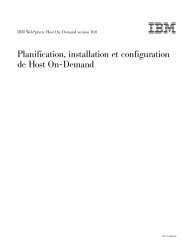Pianificazione, installazione e configurazione di Host On-Demand
Pianificazione, installazione e configurazione di Host On-Demand
Pianificazione, installazione e configurazione di Host On-Demand
You also want an ePaper? Increase the reach of your titles
YUMPU automatically turns print PDFs into web optimized ePapers that Google loves.
v -trust: in<strong>di</strong>ca se questa CA può essere considerata come atten<strong>di</strong>bile. Utilizzare leopzioni <strong>di</strong> abilitazione quando si riceve un certificato CA.v -file: il file che contiene il certificato CA.Memorizzazione <strong>di</strong> un certificato CAPer le piattaforme Windows, ad esempio, per memorizzare un certificato da unaCA non ritenuta atten<strong>di</strong>bile, immettere il seguente comando:java com.ibm.gsk.ikeyman.ikeycmd -cert -add-db <strong>di</strong>rectory_<strong>di</strong>_<strong>installazione</strong>\bin\HODServerKeyDb.kdb-pw -label -format -trust -file dove <strong>di</strong>rectory_<strong>di</strong>_<strong>installazione</strong> è la <strong>di</strong>rectory <strong>di</strong> <strong>installazione</strong> <strong>di</strong> <strong>Host</strong> <strong>On</strong>-<strong>Demand</strong>.Notare le seguenti descrizioni:v -label: l’etichetta attaccata al certificato o alla richiesta <strong>di</strong> certificatov -format: le CA potrebbero fornire un file ASCII binariov -trust: in<strong>di</strong>ca se questa CA può essere ritenuta atten<strong>di</strong>bile. Questa opzionedovrebbe essere impostata su un valore positivo.Dopo avere eseguito questa procedura, bisogna arrestare e riavviare <strong>Host</strong><strong>On</strong>-<strong>Demand</strong> Service Manager.Creazione <strong>di</strong> un’autocertificazioneOccorrono <strong>di</strong> norme due o tre settimane per ottenere un certificato da una CAnota. In attesa del rilascio <strong>di</strong> un certificato, utilizzare IKEYCMD per creareun’autocertificazione server per abilitare le sessioni SSL tra i client ed il server.Utilizzare questa procedura se si ricopre il ruolo <strong>di</strong> propria CA per una rete Webprivata.Per le piattaforme Windows, ad esempio, per creare un’autocertificazione,immettere il seguente comando:java com.ibm.gsk.ikeyman.ikeycmd -cert -create-db <strong>di</strong>rectory_<strong>di</strong>_<strong>installazione</strong>\bin\HODServerKeyDb.kdb-pw -size -dn -label -default_cert dove <strong>di</strong>rectory_<strong>di</strong>_<strong>installazione</strong> è la <strong>di</strong>rectory <strong>di</strong> <strong>installazione</strong> <strong>di</strong> <strong>Host</strong> <strong>On</strong>-<strong>Demand</strong>.Notare le seguenti descrizioni:v -size: la <strong>di</strong>mensione della chiave <strong>di</strong> 512 o 1024v -label: Immettere un commento descrittivo utilizzato per identificare la chiave e<strong>di</strong>l certificato nel database.v -dn: immettere un DN (Distinguished Name) X.500. Esso viene immesso comeuna stringa tra virgolette del seguente formato: (Sono richiesti solo CN, O e C;CN=nome_comune, O=organizzazione, OU=unità_organizzativa, L=località,ST=stato,provincia, C=paese)."CN=weblinux.raleigh.ibm.com,O=ibm,OU=IBM HTTP Server,L=RTP,ST=NC,C=US"v -default_cert: Immettere Yes, se si desidera che questo certificato sia il certificatopredefinito nel database delle chiavi. In caso contrario, immettere No.Appen<strong>di</strong>ce B. Utilizzo dell’interfaccia <strong>di</strong> riga coman<strong>di</strong> IKEYCMD 187






